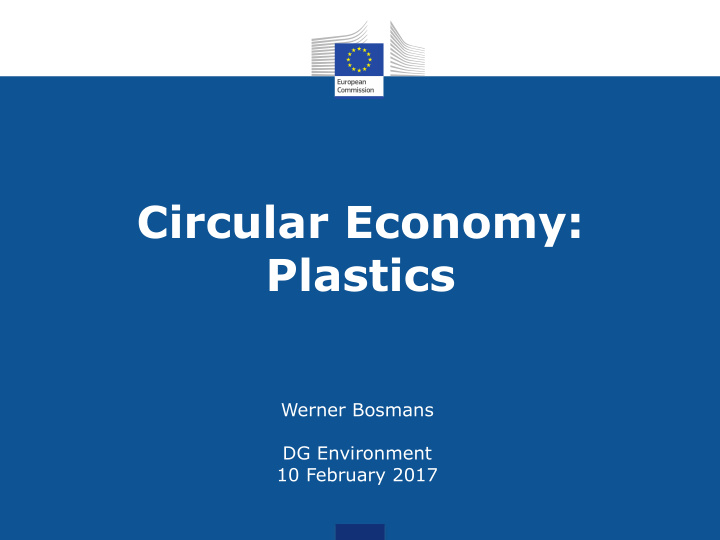



Circular Economy: Plastics Werner Bosmans DG Environment 10 February 2017
More plastic than fish in our oceans by 2050 ?
Endocrine disruptors, POPs, plastic fibres: "bon appetit!"
What to do?
Production Consumption A new Secondary materials plastic industry raw Waste Roadmap Management
Issues 1. Plastic production relies on fossil fuel with high life-cycle GHG impacts 2. The full potential of plastic reuse and recycling is yet to be used 3. Plastic leaks into the environment
1. High dependence on fossil feedstock • Raw material is cheap (> 90% from virgin material) • 400 mln T of GHG (2012) • By 2050, it could rise to: • 20% of global oil consumption • 15% of global GHG
Options • Alternative feedstock o Biomass? CO 2 ?
2. Low reuse and recycling of plastics • 25 mln T of plastic waste (2014, EU) o 30% recycled => too valuable to be burnt o 39% incinerated or landfilled o 31% landfilled • Plastic packaging: 40% • EU exports 50 % of what is collected for recycling • Virgin secondary
Options • REUSE => other business models • Better recyclability of plastics o Design => durability, reusability, reparability, recyclability o Do we need toxic plastic ? => waste, chemicals & product policy => traceability • Innovative technologies o Research & innovation for reuse, sorting & recycling
Options (2) • Legislation and incentives to support o Waste legislation: Separate collection of plastics, targets for recycling (50% in 2020, 55% of packaging in 2025) o Favour resource-efficient solutions re-use => recycling => energy recovery • Secondary plastic materials o Promote market for recycled plastics o Standards on recycled plastics to promote quality o Support industrial fora & platforms
3. Leakage into the environment • 5-13 mln T of plastic waste end up in the oceans • Problem is global • Single-use plastic products? • Cheap and disposable material that is a driver for early obsolescence • Microplastics (<5 mm) = threat to animal & human health
Options • Marine litter o Reduce microplastics o Aspirational 30% reduction target in CEAP / SDGs • Sustainability criteria for biodegradable plastics o Develop EU-harmonised criteria for biodegradability (composting) where appropriate o Assessing the use of oxo-plastics • Consumers' awareness o Raise the awareness through better information
Policy tools to address system failures • Studies : problem setting, options identification • Research for innovative technologies • Standardisation: assessment & mandate • Platform: exchanges on new business models – industrial symbiosis • Voluntary agreements • Innovation deals • Funds to support investments • Legislation • Monitor progress: performance & resource efficiency
Linear plastic is out - Circular is IN • Design! Durability, recycling, toxicity, microplastics • Incentives for collection, sorting & recycling of all plastic • Develop markets for secondary plastic Further steps: o Communication - by the end of 2017 o Possible consultation o Stakeholder reactions on the Roadmap
For your comments: the Roadmap for a Strategy on Plastics http://ec.europa.eu/smart- regulation/roadmaps/docs/plan_2016_39_plastic_strategy_en.pdf
Thank you Werner.Bosmans@ec.europa.eu refuse share reuse sort return & collect recycle
Recommend
More recommend